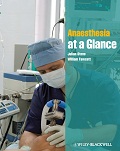A 31-year-old woman presents for an anterior cruciate ligament repair. She has a 16-year history of insulin-dependent diabetes and has moderate renal impairment. She takes 52 units of insulin daily and has had several hospital admissions due to poor diabetic control in the last 18 months.
-
1. What are the risks of this patients undergoing surgery?
Show Answer
Correct answer:
Insulin-dependent diabetic patients have a higher risk of major complications following surgery, in particular infections and renal impairment. In addition, the patients themselves may have pre-existing vascular (microvascular and macrovascular) neuropathic (peripheral and autonomic) complications. A concern with this patient is the coexistence of renal impairment and that her diabetes may be difficult to control.
-
2. What are the aims for her blood glucose during the perioperative period?
Show Answer
Correct answer:
Blood glucose should be clamped between 6 and 10 mmol/L. Whilst severe hypoglycaemia is very dangerous, it is not acceptable to allow hyperglycaemia to occur either.
-
3. How can the adequacy of diabetic control be assessed preoperatively?
Show Answer
Correct answer:
HbA1c (glycated haemoglobin) can be used as a marker of glycaemic control over the last 3 months.
-
4. What advice should be given to the patient prior to admission concerning insulin administration?
Show Answer
Correct answer:
Many advocate patients being converted to soluble (short-acting) insulin at least 24 hours prior to admission. The patient should report to hospital first thing in the morning, having had no food or insulin, for surgery first on the list.
-
5. How would you control the blood glucose perioperatively?
Show Answer
Correct answer:
A popular technique is the co-administration of dextrose and insulin according to a sliding scale. Potassium is conventionally added provided hyperkalaemia does not co-exist. This is started from admission until diet and subcutaneous insulin can be recommenced.
-
6. How can her kidneys be protected from further impairment?
Show Answer
Correct answer: Avoid hypotension, dehydration and nephrotoxic agents (e.g. NSAIDs).
-
7. What anaesthetic technique would you use?
Show Answer
Correct answer: There is no one technique that is ideal. Regional anaesthesia is preferred by some (e.g. spinal/epidural) as it may give better glucose control and earlier resumption of diet. Specific risks include hypotension (and thus renal impairment) and higher risk of infections (e.g. epidural abscess). If a general anaesthetic is used, remember that a difficult airway (and hence tracheal intubation) and reduced gastric emptying may be present.
-
8. How would you manage her postoperatively?
Show Answer
Correct answer: Early resumption of diet and normal insulin. In practice, this may be possible on the evening of surgery, or if not on the next morning. Antibiotics should be prescribed and careful observation and manipulation of blood pressure to prevent renal dysfunction. Her urea and creatinine should be checked the next day too.

